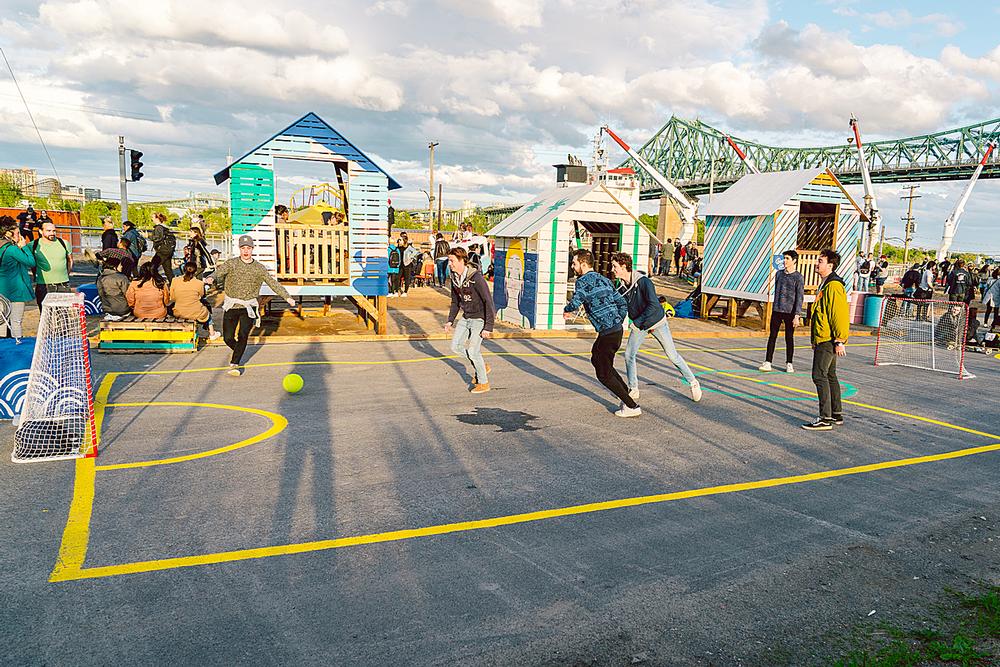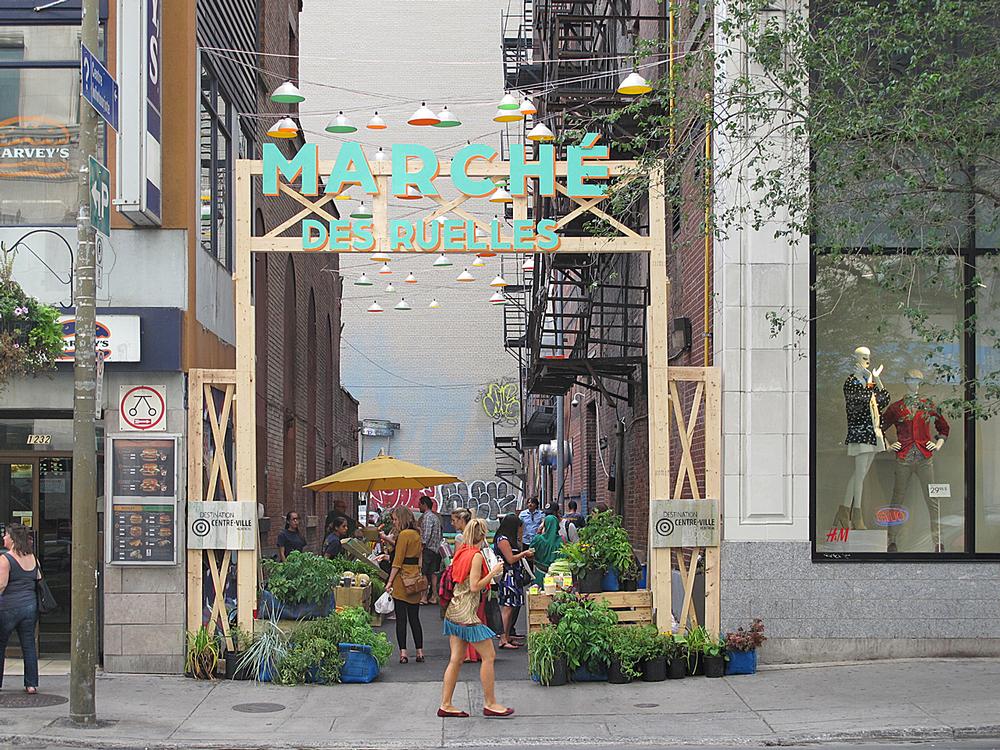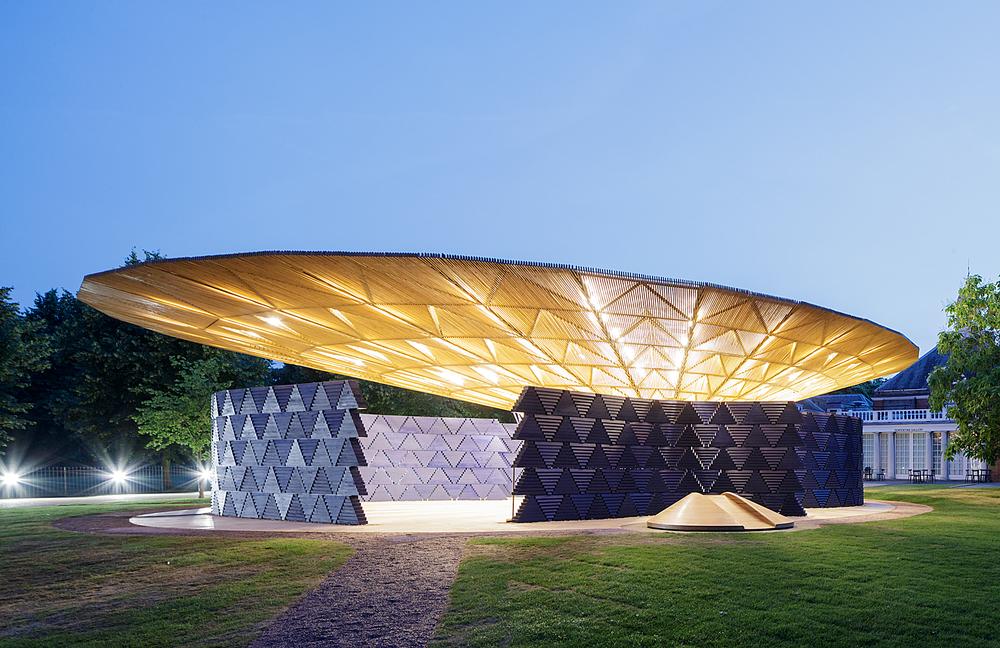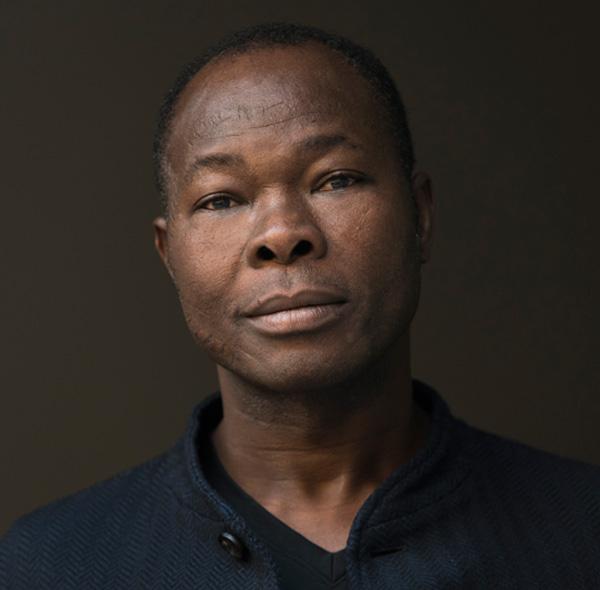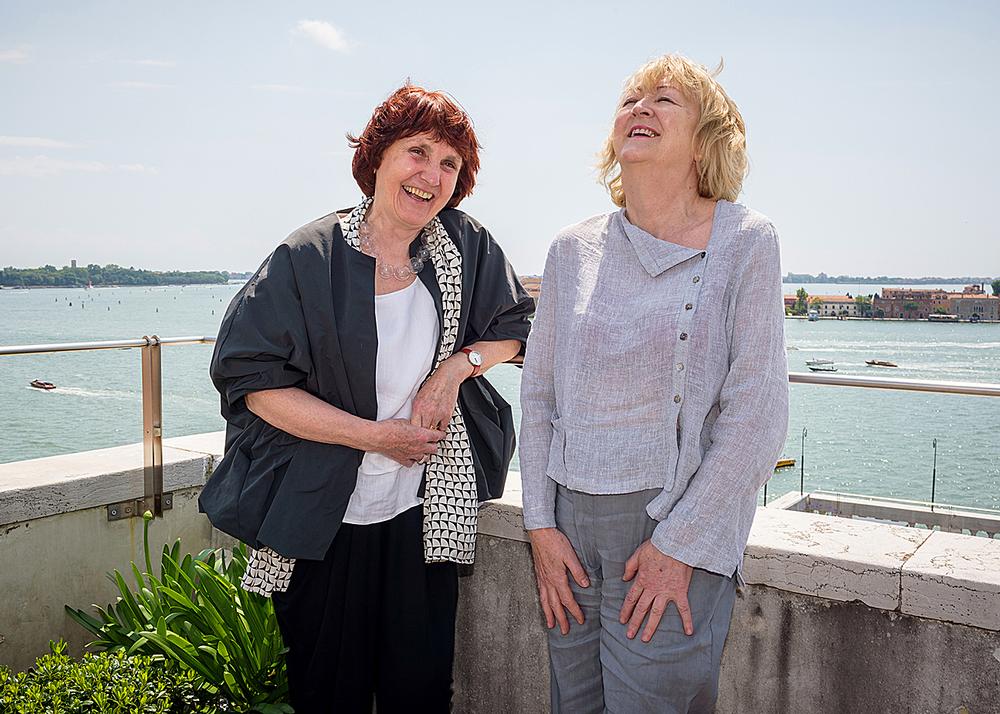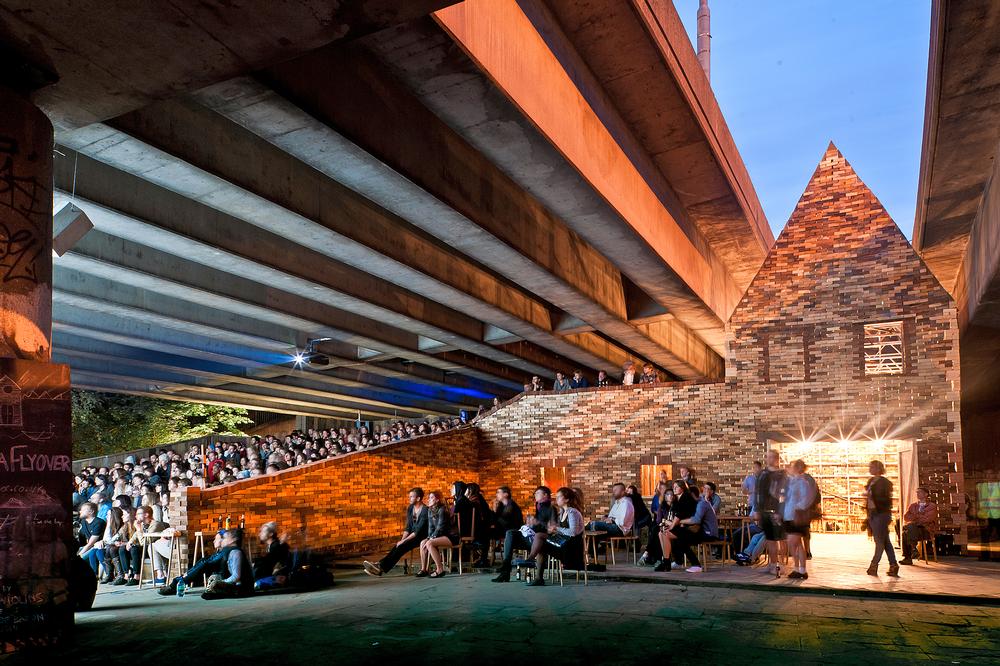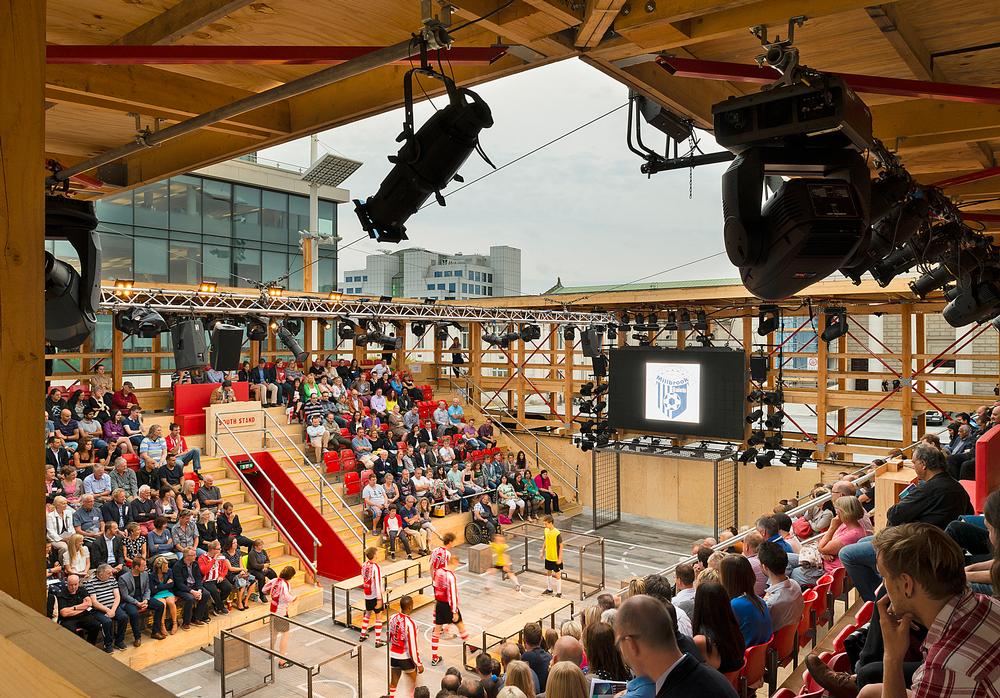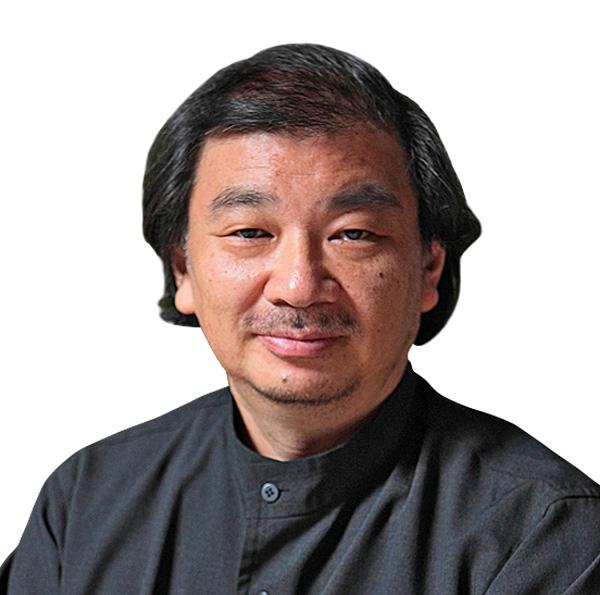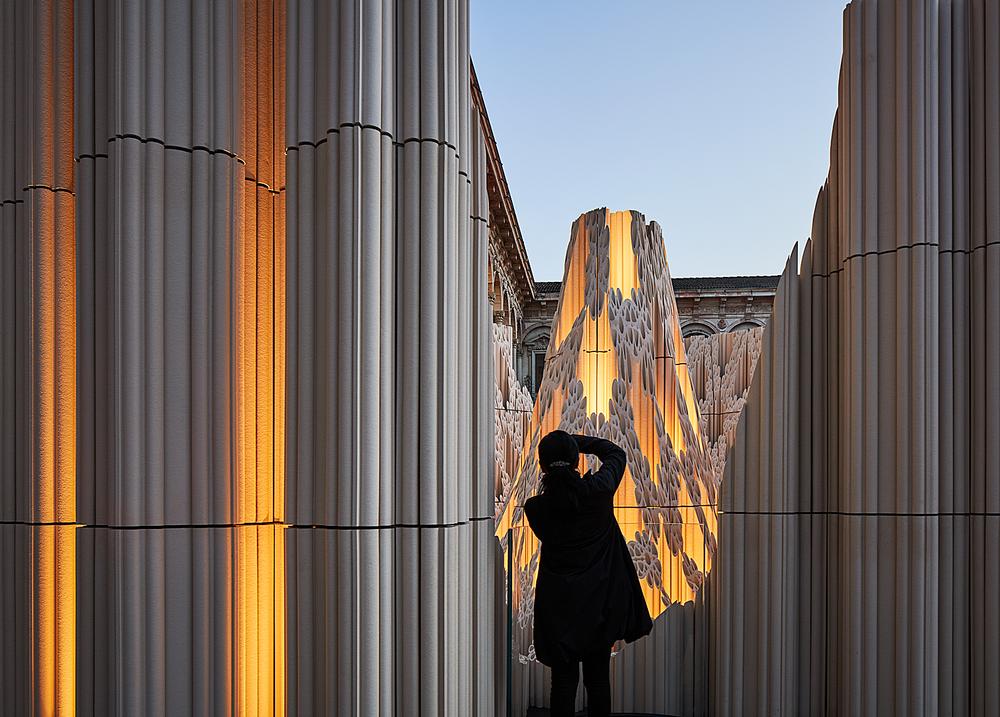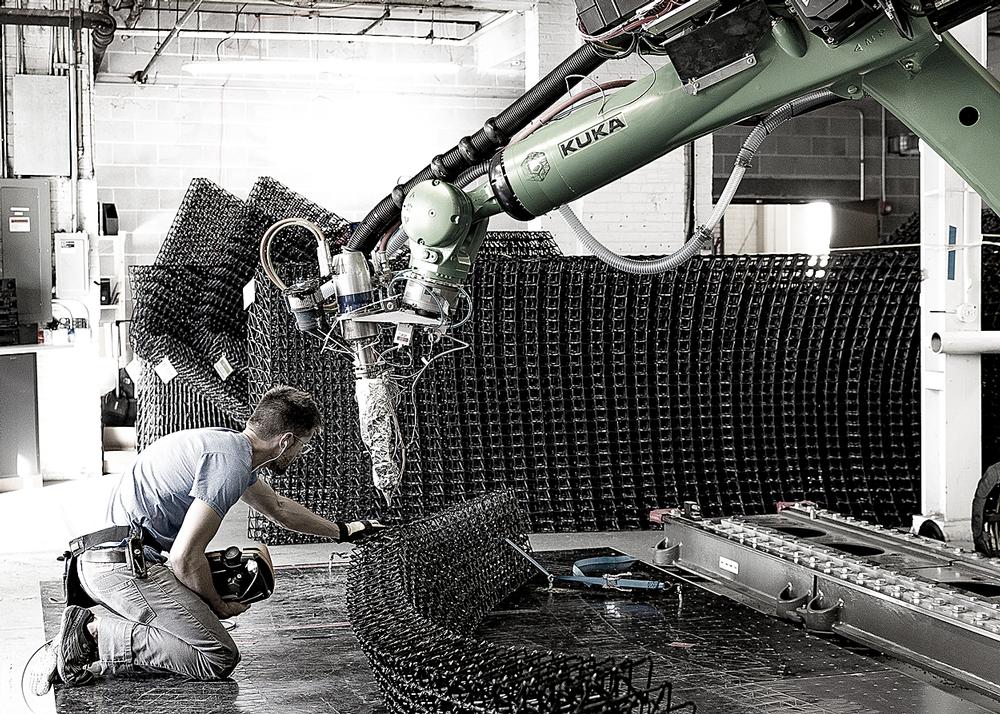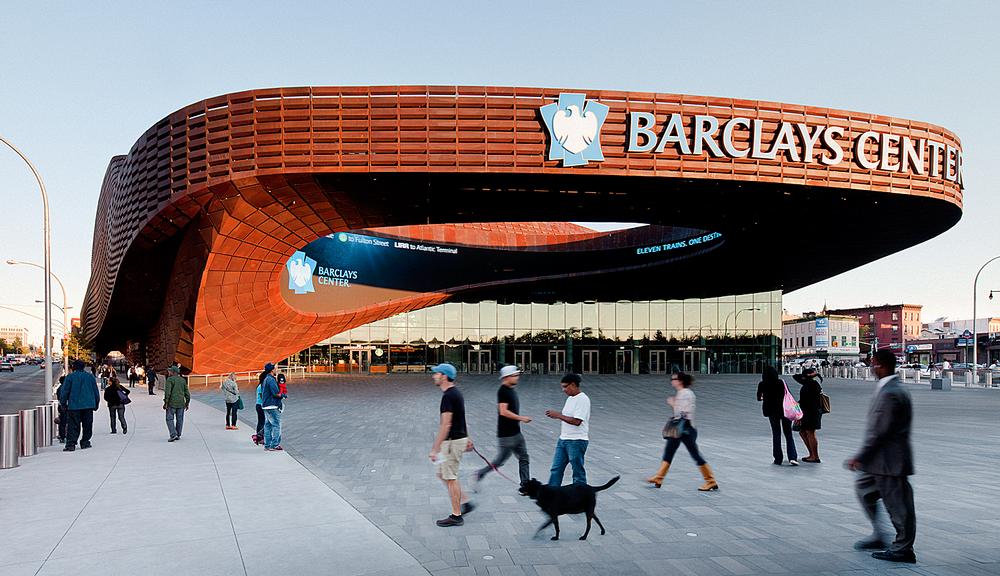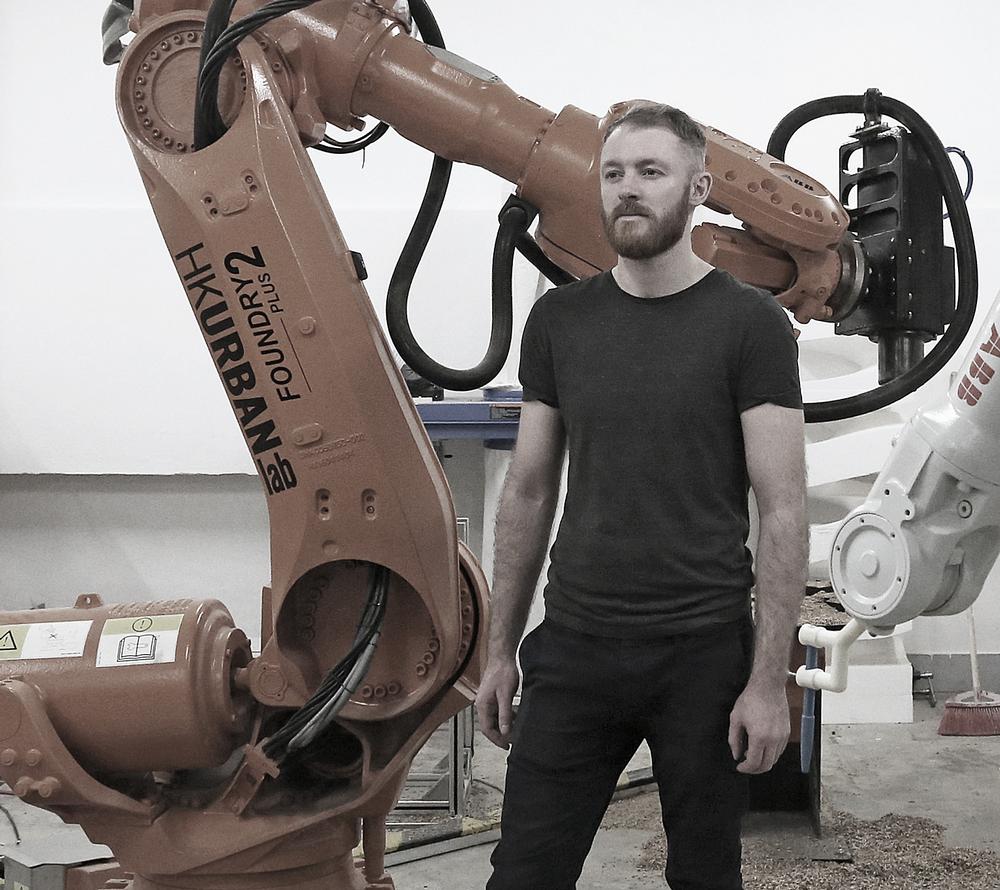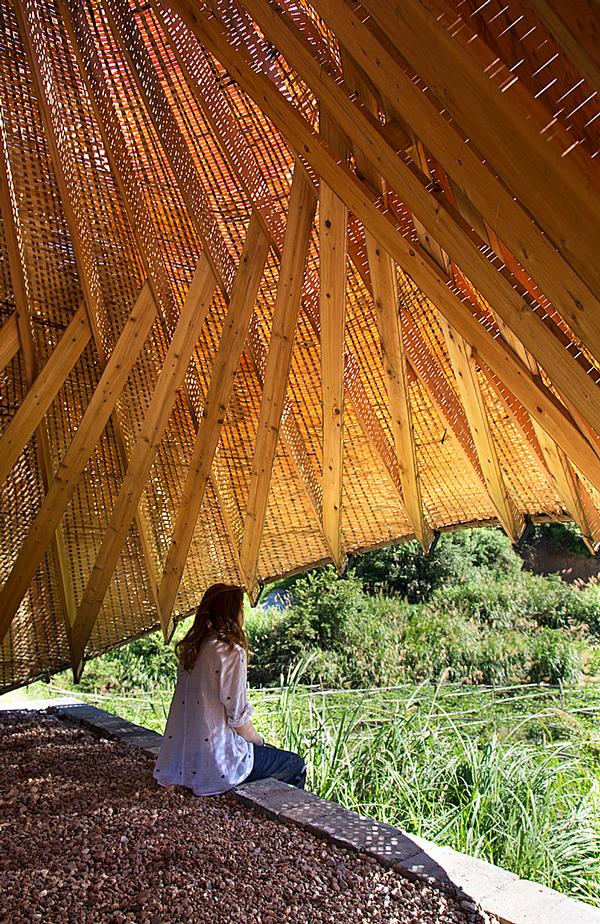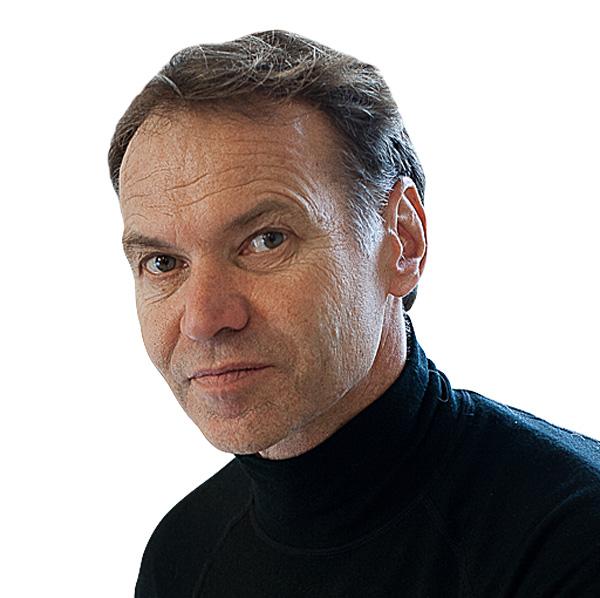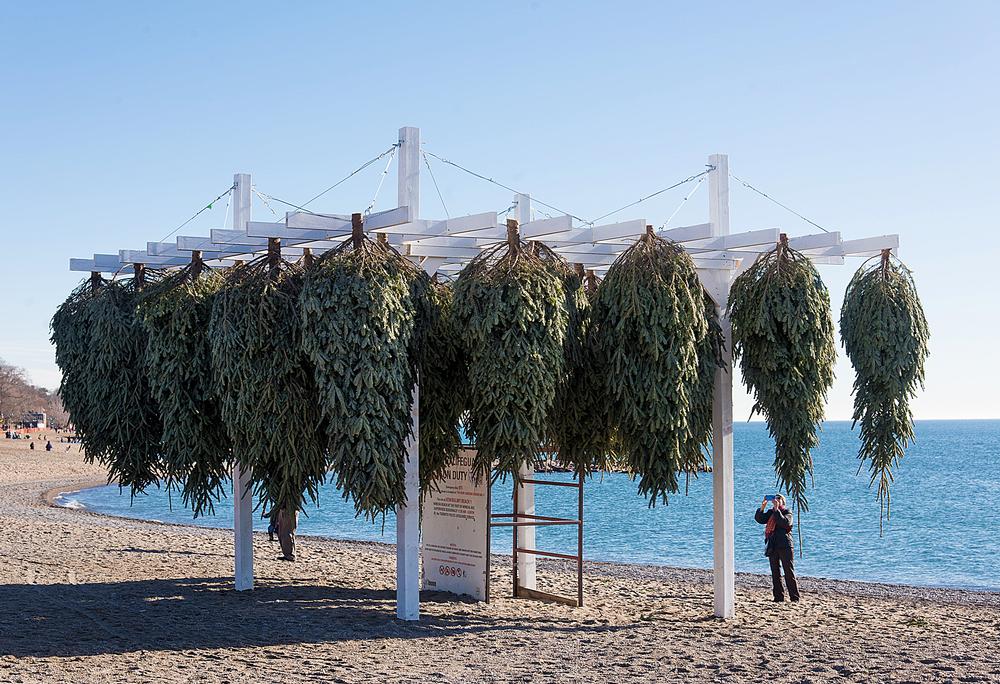features
Temporary architecture: Is architecture finally shaking off its obsession with eternity?
Designing temporary architecture gives architects the freedom to experiment, be flexible and have a little fun. Christopher DeWolf takes a look at a few intriguing projects
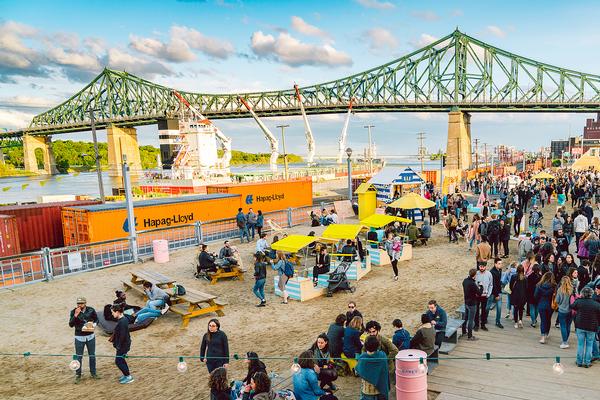
After a week of miserable weather in Montreal, the sun has finally returned and the Village au Pied-du-Courant is filling up. Visitors park their bicycles and make their way past a DJ remixing West African music. They order a pastis or a plate of Haitian food and settle into a wooden cabana. Some grab a book on architecture from the small on-site library; others play pétanque or basketball. Still more climb to the top of an observation tower to gaze down at the colourful encampment that has sprung up next to the St Lawrence River, between the green iron trusses of the Jacques-Cartier Bridge and the port cranes to the east.
A month earlier, there was nothing here but a rubble-strewn space. And that’s all that will be left a few months later. Though it has taken place every summer since 2015, the Village au Pied-du-Courant is designed to be ephemeral: here one moment, gone the next. “It’s a living lab where businesses and organisations can experiment with new practices in art and design, co-creation and sustainable development,” says Maxim Bragoli, co-founder of La Pépinière, the design firm responsible for the village, along with dozens of similar interventions in Montreal’s public spaces.
Working on a shoestring budget of government grants, La Pépinière has transformed derelict alleyways into lively markets, opened outdoor bars in the midst of Montreal’s frigid winters, and turned a neglected downtown square into a lively gathering place with a pop-up bar, urban farm and market stalls. None of the projects are intended to last more than a few months. “Compared to something permanent, an ephemeral project can take place in a very short time frame and with a very small budget,” says Bragoli. “Another advantage is that it’s agile – once it’s in place, it can be adjusted depending on the needs of its users.”
This is an approach taken by a growing number of architects and designers around the world. “Architecture is going pop. It is finally sloughing off its ridiculous obsession with eternity, and learning to live in and for the moment,” wrote architecture critic Aaron Betsky last year.
Freed from the shackles of permanence, architects have the freedom to experiment with materials, respond quickly to urgent situations and adapt in real-time to the needs and habits of the people who use their spaces.
Some of the world’s top architects use ephemeral projects as statement pieces. Every year since 2000, London’s Serpentine Galleries has commissioned a summer pavilion, and the roster of architects it has chosen include Zaha Hadid, Toyo Ito, Rem Koolhaas, Peter Zumthor, Bjarke Ingels and other game-changers. This year, Burkina Faso architect Diébédo Francis Kéré designed a circular latticed structure that has indigo-blue walls and a tilted canopy that funnels rainwater into a gushing torrent in the centre of the pavilion.
Kéré says he wanted the pavilion to evoke the experience of taking shelter under a tree. “If you look up it changes wherever you turn,” he said at the opening. “Maybe naïvely, we wanted you to still be connected to nature.” Kéré’s work channels the current spirit of architecture, which yearns for authenticity in the face of anonymous globalisation. It is perhaps not a coincidence that the curators of next year’s Venice Biennale of Architecture, Yvonne Farrell and Shelley McNamara, have said they plan to focus on “generosity and thoughtfulness” and “a desire to engage.”
Those are qualities that can be found in the work of London’s Assemble Studio, which specialises in pop-up projects with a strong community impact.
In the past, Assemble have transformed an abandoned petrol station into a temporary cinema, and built an event space beneath a London flyover that took the shape of a homely brick house. Some of the studio’s ongoing ‘live projects’ include a Glasgow junkyard playground inspired by the aphorism “better a broken bone than a broken spirit,” and a project in Bristol’s Leigh Woods that studies how children create their own play spaces. These kinds of temporary interventions sometimes lead to permanent solutions, like in New Addington’s town square, which was renovated after Assemble used installations and events to study different configurations for the space.
For more than two decades, Japanese architect Shigeru Ban has used temporary structures to fuel his Pritzker Prize-winning practice. Ban started using recycled material in the mid-1980s, and he eventually developed paper tubes that were strong enough to use as structural supports. When he saw Rwandan refugees living in terrible conditions after the 1994 genocide, he realised the paper tubes could serve as the framework for affordable temporary shelters. Since then, he has designed humane shelters for disaster victims around the world, as well as a paper school after the 2008 Sichuan earthquake. When an earthquake devastated Christchurch, New Zealand in 2011, destroying the city’s cathedral, Ban created the ethereal Cardboard Cathedral that is designed to stand in the New Zealand city for 50 years.
“What is temporary? What is permanent? I think I have made my own definition,” Ban said a year after completing the cathedral. “If people love it, they keep it. After earthquakes, ‘permanent’ buildings were easily destroyed, so what is permanent? Even concrete buildings are taken down in years if a developer wants to make something else.” More and more architects seem to be coming to the same conclusion. When Ban designed shelters for victims of the 1995 Kobe earthquake, he says he was the only architect working in the disaster area. “But when the big earthquake and tsunami took place in northern Japan [in 2011], there were so many famous architects who started working there. It’s a really positive change.”
Just as Ban’s experiments with paper structures have led to some remarkable results, other architects use temporary projects as a way to test material innovations. Last winter, Quebec City’s annual ice hotel held a competition for student architects to design themed suites using ice and snow. In Montreal, retired architecture professor Peter Sijpkes had his students test novel building forms using ice; he went so far as to design a 3D ice printer to help create the models. In Wales, Miller Kendrick Architects used jigsaw-joined birch plywood to create a stylish but affordable pop-up hotel room. Even the bath was made of plywood.
A chance to experiment
Though it has recently worked on huge projects like sports arenas and skyscrapers, New York-based SHoP Architects still uses pop-up projects to experiment with materials. In 2000, the firm unveiled Dunescape, an amorphous wood pavilion made of prefabricated wood slats. That experiment eventually led to the Barclay Center, a huge arena in Brooklyn whose curved façade is made with 12,000 pieces of pre-rusted weathering steel. “Dunescape’s DNA took about 10 years to manifest itself in the Barclay Center,” says SHoP architect John Gulliford. “It was very much the same process where we were using direct fabrication and construction automation to deploy systems on a massive scale.”
Two recent installations hold similar promise. At this year’s Material Immaterial event in Milan, SHoP created Wave/Cave, a 55sq m installation of undulating terracotta tubes. “We worked with a manufacturer who was pretty traditional – they are not digital native types who understand 3D modelling,” says Scott Overall, who worked on the project. The installation required about 3,000 drawings to guide craftsmen, so Overall’s team developed an automated, scripted process of creating them. The end result is an experiment in “creating a volume out of cladding material rather than cladding a volume,” he says. Just as Dunescape influenced the design of the Barclay Center, the process behind Wave/Cave may one day allow SHoP to more efficiently integrate terracotta into its designs.
When SHoP was hired by Design Miami to create a 155sq m gateway pavilion for its design festival last November, it embarked on yet another material exploration. Working in collaboration with 3D printing firm Branch Technology, Flotsam & Jetsam was created with bamboo printed in a lattice-like grid, creating a structure that extends outwards like a coral reef, with a variety of open and enclosed spaces, including a bar that provided enough space for a thousand champagne flutes. “3D printing gave us the freedom to go with this amorphic form,” says the project’s architect, Rebecca Caillouet.
Bamboo — affordable, fast-growing and sustainable — has proved particularly useful as a material for temporary structures. In Hong Kong, architect William Lim has used bamboo rods to create a curved sculptural bridge between two buildings, and a wind chime installation ensconced within the stone, glass and steel surroundings of the Asia Society Hong Kong. Those same kinds of rods have been used for centuries to create temporary theatres for Cantonese opera performances, and they also found their way into a curved pavilion designed by architects Adam Fingrut and Kristof Crolla to provide 350 square metres of shelter in Hong Kong’s sun-drenched Zero Carbon Park.
This year, a group of students from the University of Hong Kong, led by course leader Donn Holohan, created the Sun Room pavilion in a rural village in Fujian province. Built on a passionfruit farm and made from a woven bamboo shell that sits atop a pine wood structure, the pavilion is a contemporary spin on local huts that provide a sheltered place to meet or relax. Holohan says the project was an attempt to use bamboo weaving — a local craft normally used to make baskets — in a novel way. “There is just one very old man left who knows how to weave bamboo,” he says. “We know there is a vital need to revitalise the village, but all these traditions that are tied into the landscape are dying. This is an exploration of a material process and an experiment of how you can engage the community.”
Back in Hong Kong, architectural practice Eskyiu is wrapping up the Industrial Forest, a faux-bamboo installation on the third-floor terrace of Spring Workshop, an art space housed in a former factory building. Installed in 2013 and designed to last for four years, the installation consists of hundreds of thin metallic bamboo poles, a reference to the name of the surrounding neighbourhood: Wong Chuk Hang, or Yellow Bamboo Grove. Over the years, the installation has served as a platform for sonic experiments, an interactive play space for children and an unexpected home to psychedelic mushrooms that began growing from the stalks.
“It allows people to interact with and participate in the building of the city,” says Eskyiu co-founder Marisa Yiu. She notes that bamboo is often used to represent Hong Kong’s fast-changing vertical landscape. “It’s a trope of Hong Kong’s temporal nature,” she says. By swapping natural bamboo for aluminium that sways in the wind, evolves and degrades over time, Industrial Forest creates a multi-sensory urban space that also raises questions about the role of nature in a hyper-dense environment like Hong Kong.
Interactivity is a crucial element in many ephemeral projects. Over the past several years, Toronto’s RAW Design has used installations and pop-up spaces – which it calls “adaptable architecture” – as a way to test human behaviour. “There are very subtle things you can do with space or materials to captivate the people moving through them,” says the firm’s director, Roland Rom Colthoff. “It takes five years to do a building, but with these ephemeral pieces, it’s very immediate.”
For three years, in collaboration with landscape architects Ferris + Associates and public art consultants Curio, RAW has run Winter Stations, an annual design competition for interactive installations that allows people to use Toronto’s lakefront beaches even in the winter months. The 2017 winners include Asuka Kono and Rachel Salmela, who designed a warm foot bath inspired by Japanese hot springs, and Studio Perch, which suspends 41 fir trees in a kind of upside-down forest.
Winter Stations takes a cue from another competition in Winnipeg, which asks architects to design huts for skaters to warm themselves as they travel along the frozen Assiniboine River in the depth of winter. RAW won the competition in 2013 with Nuzzles, a metal core studded with foam pool noodles. It was a remarkably different approach compared to the sculptural wood huts designed by the previous year’s winner, Petkau Architects. “We like to be rather irreverent and poke fun at ourselves and the whole profession,” says Colthoff. “Nuzzles was a great way to invert what you would normally expect.”
The projects are a cold-weather corollary to summertime sport installations. London office Studio Octopi have created concept plans for floating pools in the River Thames and the Yarra River in Melbourne that would be naturally cleansed by tidal flows. Though the concepts remain unrealised, Paris employed a similar approach to its new summertime pool in the Canal de l’Ourcq, a formerly polluted waterway in the city’s northeast. In Mexico City, students from the Institute of Architecture and Design Chihuahua turned a defunct park fountain into a pop-up spa where neighbourhood residents could take a dip.
Colthoff says that, for architects, temporary installations are “a more casual way to interact with people and lay out the programme for buildings.” That’s true the other way around, too. The public has a chance to interact with architecture on a modest scale in a way that feels as though they have ownership. In Montreal, La Pépinière prefers using rustic, reusable materials, with plenty of wood and bright colours. Entrance arches and canopies of hanging lights are signature elements, but other than that, the existing nature of a space dictates its design. “We want to give character and magic to our projects, not just eye-catching ‘wow’ design,” says Maxim Bragoli. “We create spaces that are warm, enveloping, with a human scale.”
Bragoli says what is especially important is making sure the projects are user-centric. “All of our interventions have a social mission, and each one is a prototype or pilot project. This flexibility is an opportunity to test users and engage the community to see what they think.” That has had a knock-on effect on the way Montreal designs public spaces, with a growing emphasis on adaptability.
“We’re in the midst of creating a true systemic change in the way that people see their public space,” says Bragoli. Ephemeral architecture may be fleeting, but its legacy lives on.
